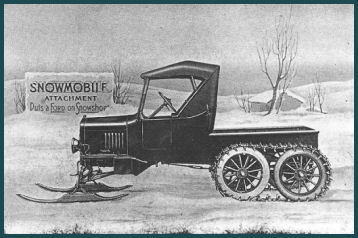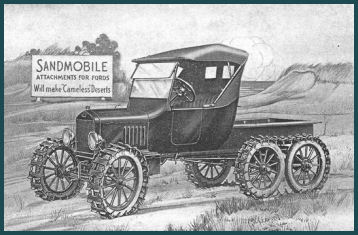|
|
|
|
A
brief history of
The Model T Ford Snowmobile |
|
|
|
|
|
The Snowmobile Company, Inc. – West Ossipee, NH
|
|
|
|
|
|
Burr!!! Old Man Winter made his unwelcome return to
the North Country. Coaxing the sleepy Model T out of the shed would take a major effort,
now. Jack up one rear wheel, push the brake lever all the way ahead, pour hot water into
the radiator, and start cranking. Trying to push the magnets of the flywheel through the
molasses-like oil in the pan made one wonder if the trip to town couldn’t wait until
spring. Time to drain the oil into a can and set it on the cook stove for a spell.
In 1917 Virgil D. White received a patent for an attachment designed to convert a Model T
into a 'Snowmobile,' a name coined and copyrighted by White. White, a Ford
dealer in Ossipee, New Hampshire, built his first snowmobile attachment 1913.
He put it on the market during the winter of 1922 after 'perfecting it in every detail,'
selling the attachments exclusively through Ford dealers. The Snowmobile attachment
consisted of the complete package necessary to convert a Ford into a reliable snow
machine. Skis made of metal and wood and rear mounted tracks were the most noticeable
differences.
|
|
|
|
|
|
 |
|
|
|
|
|
The standard passenger car rear
axle and driveshaft, rear spring, and radius rods were removed and replaced with a 7 to 1
Ford truck worm gear drive line attached to the frame by a pair of cantilevered
semi-elliptical springs. Special heavy-duty wheels to fit the TT rear axle were provided
along with anti-skip chains.
The earliest units sold by White included tracks made of metal cleats joined by a heavy
fabric. White later switched to all metal tracks consisting of stamped steel shoes
connected by chain links. Additions to the Snowmobile attachment in later years
included a special box attached to the left frame for the battery displaced by the idler
axle. A cast iron step sporting the Snowmobile insignia took the place of running
boards, which were removed to allow room for the track system.
The “Ford on Snowshoes," was offered in three different gauges. For those
living where automobiles were standard 56 inch gauge was recommended. A narrower
44-inch gauge allowed driving the Ford in the tracks of horse-drawn bobsleds. Thirty-eight
inch gauge was offered for Ford owners where narrower sleigh tracks were standard, such as
in parts of Canada. A special slip-on body of hard maple with four coats of paint
was included as part of the narrow gauge packages.
The Snowmobile became an indispensable convenience for the person requiring rapid,
dependable transport in all kinds of weather. Country doctors and rural mail
carriers were the largest users of this type of vehicle. Other customers of the
manufactured Snowmobile included public utility companies, lumber companies, traveling
salesmen, fire departments, school bus and taxi drivers, undertakers, grocers, milkmen,
truckers and cranberry growers. When the father of President Calvin Coolidge died on
March 18, 1926, a Model T Snowmobile led the Coolidge funeral procession over the
snow-covered hills of Vermont.
|
|
|
|
|
|
 |
|
|
|
|
|
Makers of the attachment claimed
the ability to travel over two and a half feet of unbroken snow at an average speed of 18
miles per hour. Those who had a Snowmobile certainly used it with great
satisfaction. The conversion kits were quite expensive. The attachment in 44 inch or
38 inch gauge for mounting on a roadster, or the 56 inch gauge for all body styles prior
to 1926, listed at $395.00 F.O.B., West Ossipee, New Hampshire. A 56-inch gauge
attachment for the one ton truck was less expensive at $250.00 because no special
driveline and suspension were needed. Heavy duty 30 x 30-1/2-inch - wheels were still
provided to mount on the rear axle, however.
With skis removed and front wheels installed; the Snowmobile became a Sandmobile, useful
for transport through deep mud and heavy sand. A number of units sold as Sandmobiles
were used in South Africa, Algeria, Egypt, and the Florida Everglades.
In 1923, White produced only about 70 units. By 1925, manufacturing rights to
produce snow automobile attachments were sold to Farm Specialty Manufacturing Company of
New Holstein, Wisconsin, which began to market its version of the product in 1926.
Farm Specialty Manufacturing Company later bought the patents of the Snowmobile Company
and sent its managers to run the factory in West Ossipee. From 1924 to 1929, the
Snowmobile Company manufactured about 3,300 units per year in its plant at West Ossipee
and had a branch warehouse at St. Paul, Minnesota. The Snowmobile Company closed in
1929, and the factory mysteriously burned down shortly thereafter.
|
|
|
|
|
|
|
|
|
|
|
|
HOME
|
|
|
|
|

